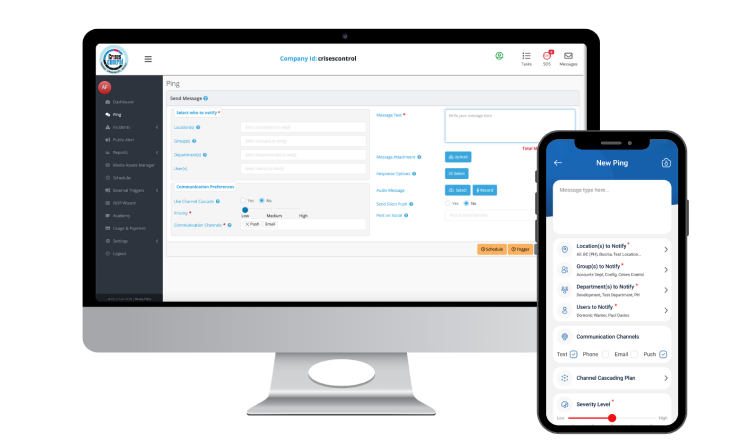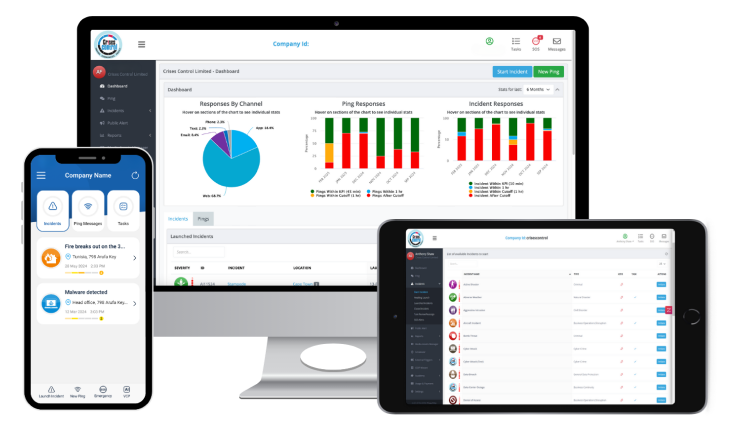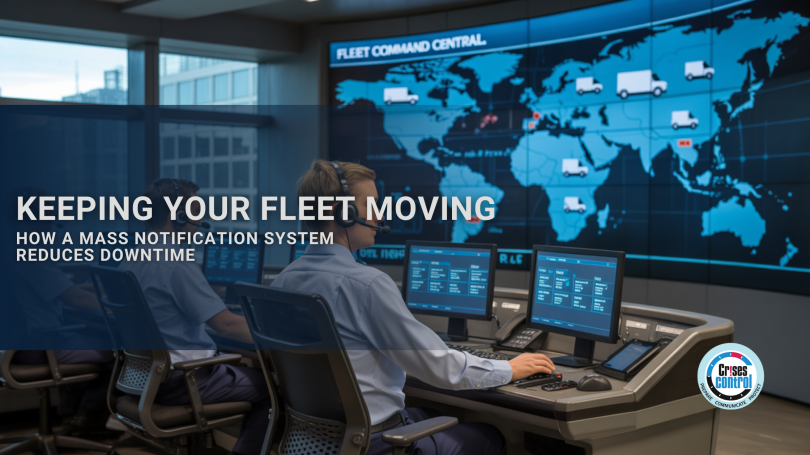Written by Anneri Fourie | Crises Control Executive
Every minute a delivery is delayed, costs pile up. Drivers stuck in traffic, warehouse staff waiting for missing shipments, or port operations halted by unexpected weather create a ripple effect across the supply chain. These delays not only cost money, but also frustrate customers and disrupt operations. The challenge is not just preventing these incidents, but reacting to them quickly enough to limit their impact. The solution lies in instant communication using a mass notification system that reaches the right people at the right time.
This blog explains how a mass notification system, together with a logistics alert system and real-time alert system, can help minimise downtime, keep fleets moving, and improve both operational efficiency and workforce safety. It also shows how Crises Control supports practical, real-world solutions for transport operators.
Understanding the Main Causes of Fleet Downtime
To solve downtime issues, it helps to know what causes them. Transport and logistics operations face several common challenges that can throw schedules off track.
Weather and Environmental Disruptions
Severe weather such as heavy rain, snow, floods, or storms can make routes unsafe, close roads, or even halt port operations. Without a fast way to communicate, drivers may remain unaware of dangerous conditions, leading to delays or accidents. For example, if a truck is en route during sudden flooding and there is no way to notify the driver or logistics teams instantly, rerouting is delayed, increasing downtime.
Accidents and Mechanical Failures
Even a well-maintained fleet can experience breakdowns. A lorry breaking down on a motorway or a forklift accident in a warehouse can halt operations. Traditional communication methods such as phone calls or emails take too long, prolonging delays. A real-time alert system allows operational teams to respond immediately, redirecting vehicles or dispatching maintenance support.
Technology Failures and Cybersecurity Risks
Modern logistics depends on software, GPS tracking, and automated warehouses. Any IT disruption, from system outages to cyberattacks, can stop operations. A transport mass notification tool can alert IT and operations teams immediately, allowing rapid action to restore services.
Compliance and Safety Incidents
Transport regulations are strict. Failing to follow safety checks, mishandling hazardous materials, or delayed incident reporting can stop operations and create legal risks. An emergency alert system ensures the right personnel are informed instantly, helping maintain safety and compliance.
Understanding these challenges shows why quick and reliable communication is crucial to keeping a fleet moving.
Why a Mass Notification System is Vital for Transport Operations
A mass notification system is more than just sending alerts. It is a centralised communication platform connecting dispersed teams, delivering critical information instantly, and supporting fast decision-making.
Instant Communication Across Teams
Drivers on the road, warehouse staff in different locations, and port operators need real-time updates. A mass notification system delivers messages through multiple channels such as app notifications, SMS, email, Microsoft Teams and voice calls. This ensures everyone receives information, even in areas with limited mobile coverage.
Faster Response to Incidents
When accidents or mechanical failures occur, every minute counts. A real-time alert system enables instant reporting of incidents and automatically escalates them to the right teams. This allows operational managers to reroute vehicles or dispatch support quickly, reducing downtime.
Workforce Safety
Keeping staff safe is essential. A logistics alert system can notify drivers about hazards on their route or alert warehouse teams to potential safety incidents. Quick alerts reduce the chance of injuries and maintain compliance with safety regulations.
Documentation and Regulatory Compliance
Mass notification systems log all messages and responses, providing proof that operational and safety communications were delivered on time. This documentation is essential for audits and regulatory inspections, helping operators demonstrate compliance.
Customer Communication During Disruptions
Delays impact customers too. Automated alerts to clients about reroutes or delivery issues keep them informed without adding pressure on internal teams. A transport mass notification system ensures customers stay updated while logistics teams focus on resolving the disruption.
How Crises Control’s Ping Module Keeps Fleets Moving
Crises Control’s Ping module is designed specifically for the transport and logistics industry, addressing the communication challenges that lead to downtime.
Targeted Alerts for Every Team
Ping allows messages to be sent to specific teams or individuals. Whether it is drivers, warehouse staff, or port operators, only the relevant people are notified, preventing unnecessary alerts while ensuring everyone who needs the information receives it instantly.
Multi-Channel Delivery
Notifications can be sent via mobile app, SMS, email, Microsoft Teams and voice call. For operations in remote areas or locations with poor mobile coverage, this ensures critical information reaches every team member.
Automated Escalation and Tracking
If an incident is not acknowledged, Ping automatically escalates alerts to supervisors or safety officers. Each notification is tracked, providing real-time records for operational oversight and management review.
Integration with Logistics Systems
Ping integrates with existing transport management systems, GPS trackers, and operational dashboards. For example, a GPS-reported vehicle breakdown can trigger instant notifications to both maintenance and logistics teams, allowing immediate action.
Audit-Ready Records
All notifications and responses are timestamped and stored securely. This provides an auditable trail, proving regulatory compliance and operational diligence.
Interested in our Ping Mass Notification Software?
Efficiently alert everyone in seconds at scale with our Mass Notification Software.

Best Practices for Using a Mass Notification System in Transport
To get the most from a mass notification system, logistics teams should follow these practices:
- Segment Your Audience: Tailor messages for drivers, warehouse staff, and office teams to reduce alert fatigue.
- Use Multiple Channels: Combine app notifications, SMS, email, and voice for maximum reach.
- Automate Alerts: Use triggers from GPS, weather warnings, or TMS events to send messages automatically.
- Set Clear Protocols: Establish escalation paths, response expectations, and reporting procedures.
- Regular Testing and Training: Conduct drills so teams know how to respond quickly when incidents occur.
These practices not only make communication faster, but also ensure alerts are acted on correctly.
Real-Life Impact of Mass Notification Systems
Companies that use our Ping mass notification system report measurable benefits:
- Significant improvements in response times to operational disruptions, in some cases by up to 96%.
- Fleet downtime is reduced, increasing on-time deliveries.
- Employee safety is enhanced, lowering risk exposure.
- Customer satisfaction improves due to timely updates.
- Complete communication records support audits and regulatory compliance.
For example, a logistics company faced a sudden port closure due to heavy flooding. Using Ping, the operations manager instantly alerted drivers and warehouse teams, rerouted trucks, and notified customers. What could have been hours of delays was reduced to under 30 minutes, preserving both operational efficiency and customer trust.
Choosing the Best Mass Notification Software for Transportation
When selecting software, look for tools that provide:
- Real-time alert capabilities for logistics teams.
- Multi-channel communication options.
- Integration with transport management and GPS systems.
- Audit-ready records for compliance purposes.
Crises Control meets all these requirements, offering a complete solution to minimise downtime and improve communication across your fleet.
Conclusion: Keep Your Fleet Moving with Crises Control
Downtime in logistics costs money, disrupts operations, and can even put employees at risk. Quick, reliable communication is essential to prevent small issues from becoming major disruptions. A mass notification system, integrated with a logistics alert system or real-time alert system, ensures that every team member knows exactly what to do and when.
Crises Control provides targeted, multi-channel alerts, automated escalation, and audit-ready records, all designed to keep your fleet moving efficiently.
To see how your operations can benefit, contact us today to arrange a free demo of Crises Control and experience real-time fleet communication in action.
Request a FREE Demo

